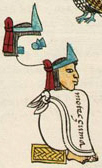The day after Tlatoani Ahuitzotl‘s ashes were interred, a council was formed to select the next ruler. There were many choices. After some discussion all the lords there selected unanimously Moctezuma, son of Tlatoani Axayacatzin, nephew of tlatoque Tizoc and Ahuitzotl. Beyond his deep royal lineage, Moctezuma was also a noted military leader and religiously devout man. He was a natural choice.
During a coronation ceremony, retold in detail by Duran, the new king vowed to care for the people of Tenochtitlan, including the old, the young, the gods and warriors. How accurate Duran’s writings are is not clear but the scene he sets is powerful.

According to Duran one of Moctezuma’s first moves was to replace most of the heads of state his uncle Ahuitzotl had appointed across the empire. He contended many were commoners and it was unbecoming of the empire to not have nobles in place. Traditional views about the role of nobility would be a hallmark of his rule, possibly making him a sort of Aztec Conservative with religion and tradition being central to his core beliefs.
Florentine Codex: “El noveno rey de Mexico, fue Motecuozoma. Segundo del nombre: y reyno desinueve anos, y en su tiempo, vino muy grande hambre, por espacio de tres anos no lluvio: pozlo qual los de Mexico, se derramara a otras tierras. En su tiemp tambien acontecio, una maravilla, en Mexico, en una otra grande, donde se juntaran a cantar, y a bailar: porque una viga grande, que estava atravesada, encima de las paredes, canto como una persona, este cantar. Veya [noqueztepole], [velxomitotia], [atlantiuetztoce], quiere dezir: guay de ti mi anca, baila bien, que estaras echada, en el agua: lo cual acontecio, quando la fama de los epsanoles, ya [sonaua] en esta tierra de mexico. En su tiempo del mismo motecuazhoma, el diablo que se nombrana Cioacoatl, de no he andaua llorando, por las calles de mexico: y lo oyan todos, diziendo. O hijos mios, guay de mi, que yo os dexo a vosotros. [Acaecio] otra senal, en tiemp do Motecoma: porque una mujer vezina de mexico tenochtitlan, murio de una enfermedad, y fue enterrada en al patio, y encima de su sepultura, pusieron unas piedras”
Pre-contact rule
Although Moctezuma is best known for his role in the Conquest, he ruled Mexico for 18 years before the Spanish arrived on the coast. To mark his own coronation, one account tells, Moctezuma led a military force against their enemy and returned to Tenochtitlan marching with thousands of captives for sacrifice. During his pre-contact rule Moctezuma expanded the Empire for the last time, south, into Chiapas and Oaxaca. He also initiated several cultural changes around his religious views, and his views on the role of nobility, replacing the meritocracy with aristocracy – nobles only in positions of power.
Facts About Moctezuma
Formal name: Motecuahzoma Xocoyotzin
Life:14 -1520
Reign: 1502-1520, 1502- (Tira de Tepechpan)
Name: Angry Lord
Place of Birth: Likely Tenochtitilan
Father: Tlatoani Axayacatl
Mother: Xochicueyetl
Arrival of the Spanish
Cortes was the third Spanish captain to show up on the coast, and the second to speak to the local Aztec leaders, Capt. Grijalva having met Aztecs the year before Cortes. Moctezuma had received reports of these strangers for over a year before he met Cortes on that fateful day in the streets of Tenochtitlan. There are many opinions on the handling of the Spanish by Moctezuma. It seems he chose a path of political protocol which ended up leading Cortes into the heart of his capital. Soon the Spanish seized Moctezuma and moved him to their quarters, a palace of the former ruler Axayacatl. He was held there until his death, most likely caused by the Spanish, but often cited as the victim of a stone cast by his countrymen in protest to his perceived weakness. There was certainly that sentiment at the time among the Mexica, who could not understand the continued entertainment of these men.
Whether by a stone to the head, or a knife to the ribs or whatever manner he died, there are also varying accounts of how his body was dealt with. One account says Moctezuma’s corpse was wrapped in cloth and left in the corner of the palace, found on the Noche Triste after the Spanish had snuck out. Another tells how Moctezuma’s own nobles carried the body out to the people, which triggered the revolt. Others say the body was unceremoniously dumped in a canal by the Spanish, and found by the Mexica. At least one account says his body was recovered and cremated in the manner of all Mexica rulers. It seem, to me, that Moctezuma died in a state of real and perceived weakness, held captive in his own city – unwilling to encourage violence against the Spanish.
Today, Moctezuma is the most well-known of the Aztec rulers. His citations and profiles are all far more numerous than any other Aztec person, expect for La Malinche, Malinali. Americans joke about “Montezuma’s Revenge” when they invariably get sick on vacations to Mexico, invoking the ghost of an angry indigenous lord. This is often the extent of information the common American has about Moctezuma. He was a noble man of intelligence and dignity but history fated him for one of its greatest demises. In his life he was an accomplished military captain, a humble and pious man, and a respected member of the nobility and he should be remembered as such.
Moctezuma II’s Accomplishments
Extended the Empire south, into Zapotec lands.
Removed commoners from power, installed nobles.
Built a palace that would come to mark the seat of power, today the site of the Presidential Palace.
